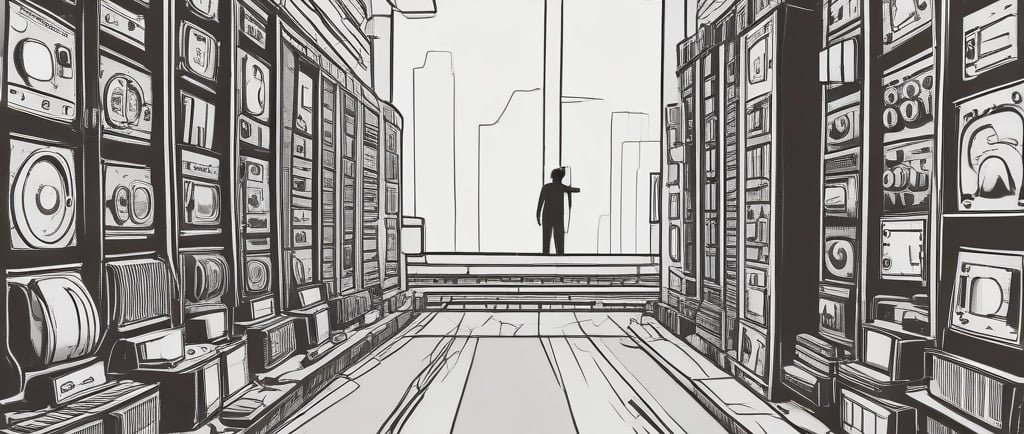The Hum of the Noise: Finding the Signal in an Age of Digital Static
There are professional blunders that fade and then there are those that singe the mind, replaying in moments of quiet with a fresh wave of heat. One of the blunders I often think back to, now with cringe and embarrassment, occurred during my first professional job, the first one that didn't graciously defer to my status as a college student. Up to this point, I had administrative work-study experience, a retail operations and corporate operations internships, delivered pizzas, and even survived a graveyard shift at the 7-Eleven near campus. But I had not yet been initiated into the culture of emotional grace of professional communication.
The evidence of my ignorance was an external email, sent with the full response of the inquiry typed into the subject line, the body of the message left unnervingly blank (in the manner of how I used my student email with classmates or professors). When the recipient replied, copying my supervisor, asking for clarification, I responded with lightning-fast dismissiveness only the ignorant can truly pull off: "I put it in the subject line. I've copied it here for your reference: '[Subject Line]'."
The cringe is still palpable. I don't make mistakes like THAT anymore. But the memory is a bookmark in time, highlighting a radical shift in my own digital consciousness. Less than a decade ago, my online communication was a utilitarian exchange of emotionless data. Today, it’s a rarity for me to send even a casual text without running it through a built-in AI copyeditor, agonizing over whether a sentence should begin with an "I" statement or a descriptive clause, or whether the sudden appearance of a period in a string of otherwise unpunctuated replies will be interpreted as a sign of passive aggression.
What happened to me? But more importantly, what is happening to us?
In a previous essay on my Substack(1), titled "The Signal & The Noise: Why True Connection Requires More Than Clicks" I borrowed Nate Silver's framework (Nate Silver's 2012 book, The Signal and the Noise: Why So Many Predictions Fail—but Some Don't, which explores the challenge of distinguishing true patterns from random data) but never fully defined my terms.
The Noise is the ceaseless, low-bandwidth, and profoundly ambiguous hum of modern digital life (texts, Teams/Slack pings, the comment sections, the direct messages) all stripped of the context that gives communication its soul and makes it human.
The Signal is the opposite: high-bandwidth, authentic communication that fosters genuine connection. It’s the clean, crisp frequency traditionally found in the analog world of face-to-face interaction, but not exclusive to it.
The defining struggle of our age is the desperate, often failing and flailing, attempt to find the Signal in the deafening roar of the Noise. As the membrane between our physical and digital realities dissolves, our brains are responding to this novel social environment, which they are not evolutionarily designed to navigate, leaving us ill-prepared to deal with sustained, low-grade psychological distress.
The Anatomy of Digital Static
Why is our digital communication so inherently prone to "static"? Because it systematically strips away the intricate, non-verbal layers that constitute the vast majority of human interaction. The loss of vocal tonality, the absence of body language, the inability to meet another's gaze. This is not a trivial loss of inefficient or redundant data, it is the loss of the very channels through which our most human tendencies such as empathy, sincerity, and trust are conveyed. Our minds, honed over millennia to read these cues with breathtaking speed and accuracy, are now flying blind.
This sensory deprivation triggers our deeply ingrained threat-detection systems. Lacking the data to confirm safety and goodwill (a smile, a relaxed posture, an embrace or friendly touch), our minds default to a state of guarded vigilance. This state of vigilance is exacerbated by the design of the platforms themselves. Social media forces us into a state of "context collapse," where too often we are speaking simultaneously to our boss, our grandmother, our ex, and a political rival from undergrad. The only rational response is to retreat into vague platitudes or curated, performative speech, further muddying the waters.
Finally, there's also the matter of asynchronous anxiety which can only be understood as the anxiety we feel in the minutes or hours between a sent text and the pulsing dots of a reply. This is due to the fat that this time lag inherent in digital conversations creates a cognitive vacuum. And nature, particularly human nature, abhors a vacuum. Our brains rush to fill that void, and they often do so with the most threatening narratives imaginable.
The Spiraling Self – Anxiety's Feedback Loop
This digital static is not a benign irritant; it is a catalyst for self-perpetuating anxiety loops. At the heart of this phenomenon is a core psychological principle: the human mind craves closure and is deeply uncomfortable with uncertainty. When faced with an ambiguous stimulus, we will invent a narrative to resolve it. Consider the feedback mechanism:
You receive an ambiguous message: a one-word text ("ok."), a delayed response to a vulnerable question, an un-liked post. This is the static.
Your brain, starved of context and primed for threat, interprets this static through a lens of pre-existing anxiety. "They're mad at me. I've been rejected. I've been misunderstood."
To mitigate this perceived risk, you craft a response that is itself guarded, delayed, or ambiguous. You hedge, you equivocate, you mirror the static you received.
This response is then received by the other person as more static, and their own anxiety-fueled interpretive process begins.
The result is a devastating spiral where both parties become more anxious, more defensive, and less connected, all based on a series of nested misinterpretations. This is a system that punishes good faith and rewards strategic opacity. It degrades the very possibility of voluntary, transparent association upon which healthy relations (and society for that matter) is built. The tool of potential exchange and collaboration becomes a minefield of perceived slights.
When the Noise Bleeds Offline
It is tempting to romanticize the analog world as a pure, untroubled repository of the Signal. But that ship has sailed. Our digital habits have fundamentally rewired our physical engagement, creating a blended, often dissonant, reality.
The behaviors we learn online now manifest in our physical interactions. We expect instant gratification in conversation, we multitask our attention by glancing at our phones mid-sentence, and we carry a pervasive fear of missing out on a conversation happening elsewhere. The physical space itself has become networked. Our social gatherings are organized through digital filters, our romantic encounters are pre-vetted by algorithms, and our very presence in a room is often secondary to the digital projection of that presence online. The Noise is no longer confined to the screen; it follows us everywhere.
This is not to say that the Signal is impossible to find online. It exists, but it requires deliberate effort. It can be found in a deep, uninterrupted video call, in the vulnerability of long-form writing, or within the shared trust of a niche online community. The medium is not an absolute prison, but it creates powerful incentives that we cannot ignore.
Tuning the Dial: A Quiet Manifesto
I often use social media as a personal scapegoat for everything, but as I continue to reflect on my own relationship with the technology of digital communication, there is no future where society collectively abandons the digital sphere entirely... Despite a recurring fantasy where all the social media network servers are destroyed, that is no tenable answer.
So, the answer must be more than that... The challenge must be to become conscious and deliberate with our communications and interactions. We must become signal cultivators and grow the communities around us to do the same.
True connection in the modern age, whether online or off, requires a conscious choice and a willed act of personal sovereignty against the pull of the algorithm and the anxiety of the void. It requires prioritizing conversations that offer clarity and bandwidth. It demands that we grant others the principle of charity, assuming good faith in their ambiguous words until proven otherwise. Most importantly, it requires that we build a resilient sense of self that is less easily swayed by the inevitable, crackling static of the digital ether.
We must choose to be the Signal. That is the only way to turn down the Noise.




